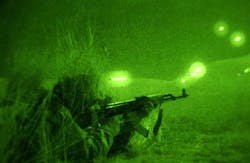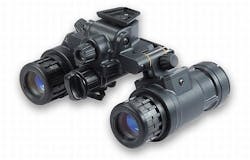Army awards $391.8 million contract to L-3 to build ENVG-B night vision electro-optical binoculars
ABERDEEN PROVING GROUND, Md. – U.S. Army night vision experts needed advanced binocular infrared and image-intensification electro-opticalbinoculars to enable U.S. and allied warfighters to operate effectively at night. They found their solution from L-3 Insight in Londonderry, N.H.
Officials of the Army Contracting Command at Aberdeen Proving Ground, Md., announced a $391.8 million three-year contract to L-3 Insight on Wednesday for the Enhanced Night Vision Goggle-Binocular (ENVG-B).
The ENVG-B project, which has unfolded this year, has been a somewhat secretive initiative with few details publicly released about its technologies and specifications because of the program's sensitive nature.
L-3 Insight is one of four U.S. electro-optics companies building versions of the ENVG. The others are Harris Corp. (formerly Exelis) in Roanoke, Va.; BAE Systems Electronic Systems segment in Nashua, N.H.; and the DRS Technologies Imaging and Targeting Solutions (ITS) segment in Dallas. Army officials say L-3 Insight was the only bidder for the ENVG-B program.
Related: Navy asks Kent Optronics to develop wide-field-of-view binocular night-vision goggles
The ENVG family represents helmet-mounted night-vision goggles that blend image intensification and longwave infrared sensors for combat at night, in bad weather, and in smoke and dust.
Image intensification amplifies available light from stars or other low-light sources, and while long-wave infrared detects temperature differences in objects to make humans, vehicles, and machinery stand out from their cooler backgrounds. Blending the two technologies in a multispectral imaging approach helps each sensor compensate for the weaknesses of the other.
Harris and L-3 Insight are building ENVG II, while BAE Systems and DRS are building ENVG III. Compared with previous versions of the ENVG, the ENVG III weapon sights also has improved resolution and a wider field of view. The ENVG III is a follow-on contract to previous ENVG I and ENVG II procurements.
The distinction of ENVG III from previous ENVGs is the added rapid target acquisition technology when used with the FWS-I, which is to be a weapon-mounted long-wave infrared sensor used for surveillance and aiming weapons during daylight, darkness, adverse weather, and dirty battlefield conditions, Army officials say.
L-3 Insight provides the AN/PSQ-20B ENVG helmet-mounted dual waveband monocular, which enables the user to view images through one eye, but not through two eyes as a binocular device can. The AN/PSQ-20B ENVG provided improved targeting and identification by fusing image intensification technology with thermal imagery to bring out the best in both sensors.
The system provides has standard 18-millimeter MX-11769 image-intensification tubes; objective focus adjustment from 18 inches to infinity; diopter adjustment from +1 to -2 diopters; meets MIL-STD-810G; has an internal shutter for auto or user initiated single point correction; and offers user-adjustable image-intensification gain and thermal brightness.
The AN/PSQ-20B ENVG is based on the L-3 Insight AN/PVS-31 Binocular Night Vision Device (BNVD) Fusion Goggle System (FGS), which offers green and white phosphor versions.
The AN/PVS-31 BNVD is a compact, lightweight, Gen III dual-tube goggle with an ergonomic low-profile design to provide better situational awareness than a single-tube goggle. Its twin-tube design provides protection in the field against failure or damage versus a single-tube device.
Related: The evolution of night-vision devices
It can be used as a monocular when necessary to allow for the dominant and non-dominant eye by rotating either the left or right optic into the stowed position. L-3 Insight designed the AN/PVS-31 BNVD to increase system resolution, reduce head-borne weight, improve system center of gravity, and improve situational awareness.
The AN/PVS-31 BNVD offers manual system gain and focus adjustments; a rotating binocular design for use with a low-profile against helmet when in stowed position; auto off when stowed; LED battery indicator in left and right monocular; replaceable image-intensification tubes; and availability for BNVIS or Aviator's Night Vision Imaging System (ANVIS) mounts.
On the ENVG-B program, L-3 Insight will do the work in locations and funding will be determined with each order, and should be finished by May 2021.
For more information contact L-3 Insight online at www.insighttechnology.com, or the Army Contracting Command at Aberdeen Proving Ground at http://acc.army.mil/contractingcenters/acc-apg.
Ready to make a purchase? Search the Military & Aerospace Electronics Buyer's Guide for companies, new products, press releases, and videos


